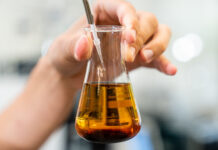Agar agar. It is extracted from some varieties of red algae (seaweed) of the Gelidium and Gracilaria genders, it is made of the two polysaccharides named agarose and agaropectine. Also this is used as a texturizing additive (thickening, gelling, etc.), and it is also widely used in microbiology to give consistence to cultivation areas. It also has interesting applications in diets, because, thanks to its capacity to swell keeping big quantities of water, is able to give satiety and it also has a slight laxative effect; these properties make it an ideal ingredient for food lines dedicated to consumers who wish to lose weight (for example drinks and snacks able to give a feeling of satiety). Then there are a series of substances extracted from algae (seaweeds) which have been discovered and/or used for food applications recently. In fact, there are about 9,000 species of macro-algae (without counting the various single-celled micro-algae), but for a long time only a dozen were considered and used for food reasons. Instead, the great potential of these species has started to interest the food industries recently.
 Pufa. It is now certain how polyunsaturated fatty acids (polyunsaturated fatty acids -PUFA-), in particular those of the omega-3 series, have important beneficial functions for our body, among which the reduction of the hematic levels of cholesterol. They are present in big quantities in various species of algae and fish is very rich in it (therefore its consumption is recommended) because it obtains them by eating these algae or marine organisms which ate them. Therefore, algae (seaweeds) or the PUFA which are extracted from them can be used both in human and animal food; in the latter case in order to obtain enriched meat and eggs. In addition, by eating the PUFA contained in algae instead of those contained in fish, it is possible to avoid contamination agents which are typical of it (heavy metals, dioxins, etc.).
Pufa. It is now certain how polyunsaturated fatty acids (polyunsaturated fatty acids -PUFA-), in particular those of the omega-3 series, have important beneficial functions for our body, among which the reduction of the hematic levels of cholesterol. They are present in big quantities in various species of algae and fish is very rich in it (therefore its consumption is recommended) because it obtains them by eating these algae or marine organisms which ate them. Therefore, algae (seaweeds) or the PUFA which are extracted from them can be used both in human and animal food; in the latter case in order to obtain enriched meat and eggs. In addition, by eating the PUFA contained in algae instead of those contained in fish, it is possible to avoid contamination agents which are typical of it (heavy metals, dioxins, etc.).
Fucoidani. They are polysaccharides extracted from brown algae (seaweeds) which seem to have various beneficial effects (5) among which the antioxiadant, anti-inflammatory, anti-tumor, and anti-obesity ones.
Other nutraceutici from micro-seaweeds. Various groups of micro-algae are used to extract numerous other nutrients in particular minerals but also vitamins, lipids, proteins, carbohydrates and fibers (in quantities whose relative abundance can be modulated). A significant advantage of the micro-algae is also that it can be easily cultivated in suitable artificial environments. This is not often applicable to micro-algae, which are picked from their marine environment with great difficulty and costs. Additional advantages of the nutrients extracted from algae (seaweeds) are the absence of gluten and allergens in general, the suitability to consumption from vegetarians and vegans, the absence of OGM, trans fats, cholesterol and the environmental sustainability.
Bibliography
Kadam SU, Prabhasankar P., Marine foods as functional ingredients in bakery and pasta products – Review Article. Food Res Internat. 2010, 43(8):1975-1980
Borthakur A, Bhattacharyya S, Anbazhagan AN, Kumar A, Dudeja PK, Tobacman JK., Prolongation of carrageenan-induced inflammation in human colonic epithelial cells by activation of an NFκB-BCL10 loop. Biochim Biophys Acta. 2012, 1822(8):1300-1307
Bhattacharyya S, O-Sullivan I, Katyal S, Unterman T, Tobacman JK., Exposure to the common food additive carrageenan leads to glucose intolerance, insulin resistance and inhibition of insulin signalling in HepG2 cells and C57BL/6J mice. Diabetologia. 2012, 55(1):194-203
Harper BA, Barbut S, Lim LT, Marcone MF., Characterization of ‘wet’ alginate and composite films containing gelatin, whey or soy protein. Food Research International. 2013 (e-pub ahead of print)
Jeon YJ, Wijesinghe WA, Kim SK., Functional properties of brown algal sulfated polysaccharides, fucoidans. Adv Food Nutr Res. 2011, 64:163-178



